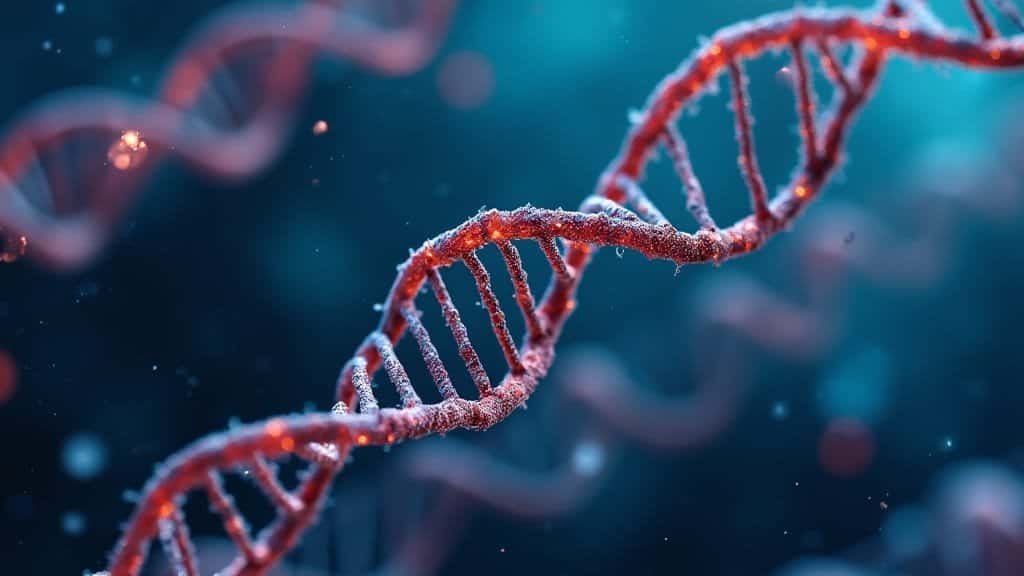Introduction
Genetic research has been instrumental in confirming the red panda’s status as a unique species, distinct from other carnivores such as bears and raccoons. Through comprehensive DNA analysis, scientists have identified unique genetic markers and evolutionary traits that set red pandas apart, shedding light on their specialized diet and habitat adaptations
This article delves into the genetic evidence that supports the red panda’s classification, examining DNA comparisons with related species, mitochondrial studies, and genetic variability within the species itself
By exploring these findings, we gain insight into the evolutionary history and significance of red pandas as a unique species within the animal kingdom
Genetic Markers and Distinctions in Red Panda DNA
Genetic studies have identified specific markers and sequences that distinguish the red panda as a unique species within the animal kingdom, separate from bears, raccoons, and other carnivores
Through nuclear and mitochondrial DNA analysis, researchers have determined that red pandas have distinct genetic characteristics that support their classification as a sole representative of their family, Ailuridae
Here, we explore how DNA comparisons, unique genetic sequences, and mitochondrial data contribute to the red panda’s unique classification
Comparison of Red Panda DNA with Bears and Raccoons
Historically, red pandas were thought to belong to either the bear family (Ursidae) or the raccoon family (Procyonidae) due to physical similarities
However, genetic analyses using nuclear DNA have shown that the red panda’s genetic makeup is distinctly different from both. In a study by Wei et al. (2018), DNA sequencing of red pandas revealed that their genome differs significantly from those of bears and raccoons, suggesting an independent evolutionary path
This study showed that while red pandas and raccoons share some superficial morphological traits, the genetic divergence between them is substantial, confirming that red pandas are neither raccoons nor bears but rather belong to their own family
Further phylogenetic studies involving bears, raccoons, and red pandas have confirmed that red pandas diverged from other carnivores about 30 million years ago. This separation places them as a unique lineage within the order Carnivora, supporting their classification under the family Ailuridae
Such findings are critical because they resolve the longstanding debate over the red panda’s taxonomic placement, clarifying their position as an independent branch of the carnivore evolutionary tree
Unique Genetic Sequences Defining Red Pandas
Genomic studies have identified several unique sequences in red pandas that are absent in other carnivores, further supporting their unique classification. Hu et al. (2020) identified specific gene sequences related to bamboo digestion, which are unique to red pandas and are not found in other meat-eating carnivores
These sequences are linked to adaptations in the digestive tract that allow red pandas to efficiently process bamboo, a low-nutrient, fibrous plant
Such sequences are crucial for a diet that relies almost exclusively on bamboo and illustrate evolutionary adaptations that are exclusive to the red panda
In addition, certain olfactory and sensory genes in red pandas have evolved in ways distinct from those in bears and raccoons. These unique genes play a role in olfactory sensitivity, allowing red pandas to detect subtle chemical cues in their environment, an essential skill for survival in dense bamboo forests
The presence of these unique genes suggests that red pandas have undergone specific adaptations to their ecological niche, which is distinct from the habitats occupied by their distant carnivorous relatives
Role of Mitochondrial DNA in Classification
Mitochondrial DNA (mtDNA) has been particularly useful in studying the evolutionary history of red pandas. MtDNA, inherited maternally and evolving rapidly, allows scientists to trace lineages and understand genetic divergence over time
Li et al. (2019) conducted a comprehensive analysis of red panda mitochondrial DNA, comparing it with mtDNA from other carnivore families. Their findings revealed significant genetic divergence, supporting the idea that red pandas split from other carnivorous lineages millions of years ago, thus representing an ancient, distinct lineage within Carnivora
Mitochondrial studies have also helped clarify differences within red panda populations, identifying two primary subspecies with distinct genetic lineages: the Himalayan red panda (Ailurus fulgens fulgens) and the Chinese red panda (Ailurus fulgens styani)
These subspecies display enough genetic variation to support the classification of red pandas as a unique species while emphasizing the need to preserve genetic diversity within the species
The combination of nuclear and mitochondrial DNA evidence not only highlights the evolutionary distinctiveness of the red panda but also solidifies its classification as a unique species, with genetic traits that have allowed it to thrive in a specialized ecological niche
Evolutionary Significance of Red Panda Genetics
The red panda’s unique genetic makeup provides valuable insight into its evolutionary path and supports its classification as a distinct species
Genetic evidence reveals that red pandas followed a separate evolutionary trajectory from other carnivores, and their adaptations to a bamboo-based diet set them apart within their order
Here, we examine how genetic evidence demonstrates a unique evolutionary lineage, the implications of shared ancestry with other carnivores, and the specialized genes that support their bamboo diet
Genetic Evidence of a Separate Evolutionary Path
Genomic studies show that red pandas diverged from the main carnivore lineage millions of years ago, establishing their own family, Ailuridae
According to Wei et al. (2018), red pandas split from their closest relatives within Carnivora approximately 30-40 million years ago, likely due to distinct environmental pressures that shaped their evolution
This genetic isolation has led to a range of unique adaptations, from dietary specialization to physical traits, that are not seen in other carnivorous families like bears (Ursidae) or raccoons (Procyonidae)
The red panda’s unique evolutionary lineage underscores its distinct place within Carnivora, where it stands as a solitary representative of an ancient lineage. This evidence challenges previous assumptions that classified red pandas with either raccoons or bears and emphasizes the unique evolutionary pressures that shaped their development
Such genetic insights confirm that red pandas represent a separate evolutionary path, making them a unique component of global biodiversity
Common Ancestry and Divergence from Carnivores
Although red pandas are genetically distinct, they share a distant common ancestor with other carnivores. DNA studies reveal that this common ancestor likely exhibited typical carnivorous traits, such as sharp teeth and a meat-based diet
However, as red pandas diverged from this lineage, they gradually adapted to a herbivorous diet, specializing in bamboo. These evolutionary changes are evidenced by mutations and adaptations in their genome that support a diet unlike that of their carnivorous relatives
The genetic divergence from other carnivores has led red pandas to develop distinctive traits. While their closest relatives evolved toward traditional carnivorous roles, red pandas developed traits tailored to their mountainous bamboo forests
According to Hu et al. (2020), some red panda genes associated with olfactory and dietary adaptations reflect these unique environmental pressures, highlighting a shift from carnivorous traits to adaptations that support a bamboo-based diet
Implications of Specialized Dietary Genes
A key aspect of red panda genetics is the set of genes associated with their specialized bamboo diet, a rare trait among mammals in the carnivorous order. Genetic research has identified several adaptations in digestive enzyme genes, which enable red pandas to break down cellulose in bamboo
While their carnivorous relatives lack these adaptations, red pandas have evolved enzymes that help extract sufficient energy and nutrients from bamboo, making up for the plant’s generally low nutritional value
Wang and Xu (2018) identified specific genes in red pandas that influence taste receptors, particularly those that reduce sensitivity to bitter flavors. This adaptation allows red pandas to consume a greater variety of bamboo types, many of which have naturally bitter components that would be unpalatable to other animals
These dietary genes not only demonstrate the unique adaptations of red pandas but also highlight the significant genetic evolution that has occurred within their lineage, further reinforcing their status as a unique species
Together, these evolutionary traits reveal a distinct genetic identity that reflects millions of years of adaptation to a specialized diet and habitat
The presence of these unique dietary genes highlights the red panda’s specialized place within the animal kingdom and reinforces its classification as a distinct, irreplaceable species within the Carnivora order
Genetic Variability Between Red Panda Subspecies
Genetic research has shown that there are two primary subspecies of red pandas: the Himalayan red panda (Ailurus fulgens fulgens) and the Chinese red panda (Ailurus fulgens styani)
Each subspecies exhibits unique genetic traits, reflecting their geographic distributions and adaptations to slightly different habitats
This section explores the genetic differences between these subspecies, their adaptive traits, and the importance of preserving genetic diversity for red panda conservation
Geographic Distribution and Genetic Differences
The Himalayan red panda is primarily found in the mountainous regions of Nepal, Bhutan, and northern India, while the Chinese red panda resides in southern China
Genetic studies by Zhang et al. (2021) have revealed significant genetic differentiation between these two subspecies, particularly in genes related to their environmental adaptations. This genetic divergence likely results from geographical isolation, with each subspecies adapting to the specific conditions of its regional habitat
The distinction between the two subspecies is supported by mitochondrial DNA analysis, which shows a divergence that occurred several hundred thousand years ago. Such divergence reflects adaptations to varying climates, food availability, and even altitude differences within their respective ranges
These genetic differences, while subtle, underscore the need to treat these subspecies independently in conservation planning, as each may respond differently to environmental changes
Unique Lineages and Adaptive Traits
Both subspecies of red panda have developed distinct genetic adaptations to help them thrive in their respective environments. For example, the Himalayan red panda, which lives in colder, higher altitudes, has shown adaptations in genes related to thermal regulation and oxygen transport
These genetic traits help this subspecies survive in harsher, colder climates with lower oxygen levels, allowing it to conserve energy and maintain body warmth
The Chinese red panda, on the other hand, has genetic traits that support survival in more temperate, densely forested areas with slightly higher temperatures and greater humidity. Research by Li et al. (2019) highlights specific genetic variations that may support a higher tolerance for warmer environments in the Chinese red panda compared to its Himalayan counterpart
These adaptive traits reinforce the unique ecological niches that each subspecies occupies and underscore the importance of habitat preservation efforts tailored to each group
Conservation Significance of Genetic Diversity
The genetic differences between the two red panda subspecies are crucial for the species’ overall adaptability and survival. Genetic diversity within and between these subspecies provides a broader genetic pool that can offer resilience against environmental changes, diseases, and other threats
Conservationists emphasize the importance of maintaining genetic diversity to support red panda populations in the face of global warming, habitat fragmentation, and food scarcity
Preserving genetic diversity is particularly important for the smaller, more isolated populations of red pandas, as genetic bottlenecks and inbreeding can reduce the overall health and survival potential of these populations. Conservation programs, including habitat corridors and breeding programs, are being implemented to protect both subspecies and maintain genetic flow between populations
Studies by Davis and Roberts (2022) indicate that these efforts are essential for ensuring the survival of both subspecies, as they allow for genetic exchange that can strengthen overall resilience
By recognizing and protecting the genetic diversity of these subspecies, conservationists can create more effective, targeted strategies for preserving red pandas
This approach helps ensure that both the Himalayan and Chinese red pandas maintain the adaptive traits that have allowed them to survive in distinct habitats, supporting a healthy and sustainable red panda population overall
Key Findings from Genomic Studies
Genomic research has been fundamental in establishing the red panda as a unique species within the animal kingdom, distinguishing it from other carnivores through detailed analysis of its genetic makeup
The studies conducted on red panda DNA have provided crucial insights into their evolution, adaptive traits, and dietary specialization
Here, we review landmark studies that have shaped our understanding of red panda genetics, explore the methodologies used in these investigations, and discuss future directions for red panda genetic research
Landmark Studies Defining Red Panda Genomics
Several pioneering studies have played an essential role in confirming the red panda’s unique status. The study by Hu et al. (2020) was a breakthrough, providing a complete genomic sequence for the red panda and comparing it to other members of the Carnivora order
This study identified distinctive genetic traits that separate red pandas from raccoons, bears, and other relatives, particularly in genes related to bamboo digestion and cold adaptation. By establishing red pandas as the sole members of the Ailuridae family, this research resolved historical classification debates and highlighted the distinct lineage of red pandas
Wei et al. (2018) also contributed a significant study by examining nuclear and mitochondrial DNA markers to explore red panda evolutionary history
This research reinforced the idea that red pandas split from other carnivores millions of years ago, supporting their classification as an ancient and independent branch within the Carnivora order. These foundational studies have provided a basis for understanding red panda genetics and the unique evolutionary path they followed
Methodologies Used in DNA Analysis
Genomic studies on red pandas employ a variety of advanced techniques, including whole-genome sequencing, nuclear DNA analysis, and mitochondrial DNA (mtDNA) sequencing
Whole-genome sequencing allows scientists to examine all genes and identify unique genetic markers that set red pandas apart from other species. This method has been especially useful in highlighting the unique adaptations red pandas have developed, such as genes for bamboo digestion
Mitochondrial DNA analysis, which involves studying the maternally inherited portion of the genome, has provided insights into the evolutionary divergence of red pandas from other carnivores
This method is particularly valuable for tracing lineage and evolutionary timelines, as mtDNA evolves more quickly than nuclear DNA. Studies like those by Li et al. (2019) have used mtDNA to trace the genetic divergence between red panda subspecies, further clarifying the species’ evolutionary history
Another key methodology is comparative genomics, which compares the red panda genome to that of closely related species to identify unique traits
By analyzing these genetic differences, scientists can pinpoint specific genes that enable red pandas to thrive in high-altitude, bamboo-rich environments. This comparative approach has been essential in identifying the adaptive genetic traits that distinguish red pandas from their carnivorous relatives
Future Directions for Red Panda Genetic Research
While genetic research has provided critical insights into the red panda’s unique classification, there is still much to explore
One priority for future research is the examination of red panda genetic diversity across populations, particularly as climate change and habitat fragmentation increasingly impact red panda habitats
Understanding the genetic variation among populations can help conservationists implement strategies that maintain genetic diversity, which is essential for the species’ long-term adaptability
Another promising area is the study of epigenetic factors, which could provide a deeper understanding of how environmental changes affect gene expression in red pandas. Epigenetics examines how external factors influence the activation or suppression of certain genes, and it could reveal how red pandas are adapting to changing habitats in real-time
Additionally, conservationists are interested in exploring gene editing techniques that could help address health challenges or promote resilience in endangered populations, though such techniques remain primarily theoretical for wild species
Expanding genetic studies to cover a wider range of populations, particularly those in fragmented or isolated habitats, will further strengthen conservation efforts. By deepening our understanding of the genetic and epigenetic mechanisms that support red panda survival, future research can help create adaptive strategies that address emerging environmental pressures
These studies will be instrumental in ensuring that red pandas, with their distinctive genetic lineage and unique evolutionary history, continue to thrive in the face of ongoing ecological challenges
Conclusion
Genetic evidence has been pivotal in confirming the red panda’s classification as a unique species, distinct from bears, raccoons, and other members of the Carnivora order
Through comprehensive genomic studies, scientists have established that red pandas possess unique genetic markers, particularly in genes related to dietary adaptation and environmental resilience, which underscore their placement in their own family, Ailuridae
Key genetic studies have demonstrated that red pandas diverged from other carnivores millions of years ago, evolving distinct characteristics that support their bamboo-centered diet and high-altitude habitats
Genetic research has also revealed important distinctions between the Himalayan and Chinese red panda subspecies, which display unique adaptations to their respective environments. Preserving this genetic diversity is crucial for red panda conservation, as it enhances the species’ resilience in the face of climate change, habitat fragmentation, and other ecological pressures
Conservation strategies now leverage these genetic insights to protect red panda populations more effectively, from habitat restoration to adaptive management tailored to the specific needs of each subspecies
As future studies explore deeper aspects of red panda genetics, including epigenetic factors and genetic diversity across populations, these insights will continue to shape effective conservation approaches
By safeguarding their genetic uniqueness and understanding their evolutionary history, scientists and conservationists work to ensure that red pandas remain a thriving, irreplaceable part of global biodiversity





